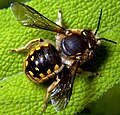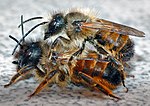 | of sex Honeybee starvation Pollen calendar Pollen count Pollen DNA barcoding Pollen source Polyphenol antioxidant Bee pollen "Best and Worst Flowers for... 50 KB (5,640 words) - 08:33, 19 April 2024 |
 | The pollen basket or corbicula (plural corbiculae) is part of the tibia on the hind legs of the female of certain species of bees. They use the structure... 8 KB (859 words) - 13:51, 7 May 2023 |
 | honey bee. Western honey bee foragers loaded with pollen on the hive landing board Eastern honey bee (A. cerana) in Hong Kong Giant honey bee (A. dorsata)... 95 KB (11,245 words) - 05:29, 1 May 2024 |
two bees run into a group of pollen jocks, bees who collect pollen from flowers outside the hive, and they offer to take Barry with them if he is "bee enough"... 43 KB (3,671 words) - 15:46, 16 April 2024 |
 | Pollination (redirect from Pollenation) focused on bees, and how the process affects the pollinators themselves. Pollen germination has three stages; hydration, activation and pollen tube emergence... 72 KB (8,829 words) - 00:53, 11 April 2024 |
Beekeeping (redirect from Bee-keeping) stingless bees are also kept. Beekeepers (or apiarists) keep bees to collect honey and other products of the hive: beeswax, propolis, bee pollen, and royal... 88 KB (9,822 words) - 18:33, 25 April 2024 |
 | Bumblebee (redirect from Bumble Bee) (those with pollen baskets) in the Apidae, the others being the Apini (honey bees), Euglossini (orchid bees), and Meliponini (stingless bees). The corbiculate... 106 KB (11,481 words) - 02:04, 1 April 2024 |
 | Colony collapse disorder (redirect from North American bee disappearance of 2007) in CCD bees. These traits express at various degrees across four bee age groups (newly emerged bees, nurse bees, non-pollen foragers, and pollen foragers)... 138 KB (15,458 words) - 13:36, 26 April 2024 |
 | term pollen source is often used in the context of beekeeping and refers to flowering plants as a source of pollen for bees or other insects. Bees collect... 20 KB (554 words) - 04:53, 4 August 2023 |
pollination whereby pollen is distributed by insects, particularly bees, Lepidoptera (butterflies and moths), flies and beetles. Honey bees pollinate many... 18 KB (384 words) - 17:55, 29 December 2023 |
Hive management (section For pollen production) harder for the foraging bees. In the process of climbing through the pollen trap wires some pollen is loosened from the bee's pollen basket and falls into... 9 KB (1,242 words) - 16:29, 18 February 2022 |
 | Africanized bee, also known as the Africanized honey bee (AHB) and colloquially as the "killer bee", is a hybrid of the western honey bee (Apis mellifera)... 56 KB (6,413 words) - 21:50, 1 April 2024 |
 | Apitherapy (redirect from Bee Venom Therapy) of alternative medicine that uses honey bee products, including honey, pollen, propolis, royal jelly and bee venom. There has been no scientific or clinical... 11 KB (1,149 words) - 16:46, 7 February 2024 |
 | Megachilidae (redirect from Megachilid bee) cosmopolitan family of mostly solitary bees. Characteristic traits of this family are the restriction of their pollen-carrying structure (called a scopa)... 16 KB (1,651 words) - 16:46, 10 December 2023 |
often used when pollenizer is more precise. A pollinator is the biotic agent that moves the pollen, such as bees, moths, bats, and birds. Bees are thus often... 2 KB (259 words) - 17:09, 11 January 2024 |
immature bees. The secretions replace the role of both pollen in the bees' diet, as vulture bees lack adaptations for carrying pollen and pollen stores... 7 KB (920 words) - 22:10, 14 April 2024 |
 | Bombus subgenus Psithyrus. Females of cuckoo bees are easy to recognize in almost all cases, as they lack pollen-collecting structures (the scopa) and do... 3 KB (411 words) - 20:41, 23 March 2024 |
 | Osmia bicornis (redirect from Red mason bee) or stems and is polylectic, meaning it forages pollen from various different flowering plants. These bees can be seen aggregating together and nests in... 34 KB (4,271 words) - 10:48, 11 August 2023 |
 | Apis cerana (redirect from Chinese honey bee) by individuals of another nest. The diet of this honey bee species consists mostly of pollen and nectar, or honey. Moreover, Apis cerana is known for... 41 KB (5,105 words) - 15:36, 23 April 2024 |
 | For bees, their forage or food supply consists of nectar and pollen from blooming plants within flight range. The forage sources for honey bees are an... 3 KB (428 words) - 09:01, 24 January 2022 |









